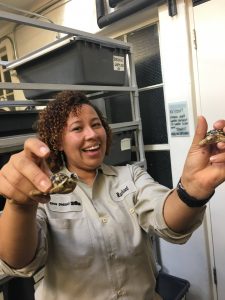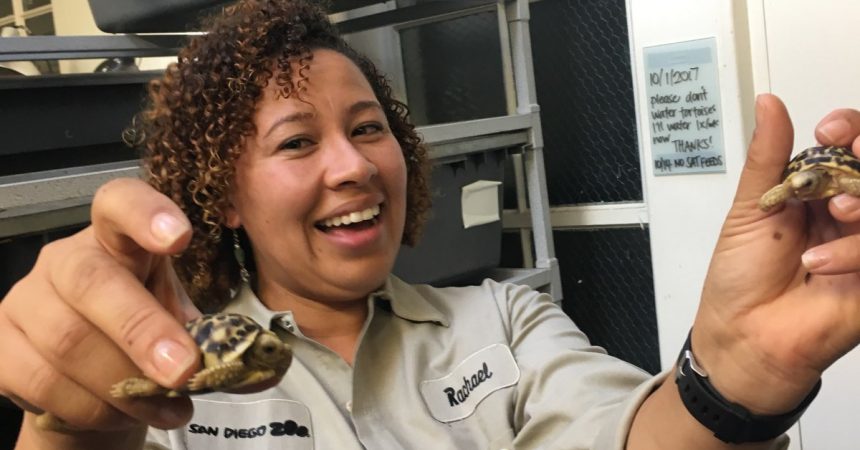Zoo InternQuest is a seven-week career exploration program for San Diego County high school juniors and seniors. Students have the unique opportunity to meet professionals working for the San Diego Zoo, Safari Park, and Institute for Conservation Research, learn about their jobs, and then blog about their experience online. Follow their adventures here on the Zoo’s website!
 While reptiles are known for being creepy critters, they also are some of the most specular animals on the planet. This afternoon, we went down to the Reptile House to meet with Ms. Rachael Walton, a Senior Reptile Keeper at the San Diego Zoo. Throughout our experience, we got to go behind the scenes, actually going inside the Reptile House to get a closer look at some of the Zoo’s reptile and amphibian collection. All the while, Ms. Walton shared with us what she does on a day-to-day basis, and what the Zoo is doing to conserve these incredible creatures.
While reptiles are known for being creepy critters, they also are some of the most specular animals on the planet. This afternoon, we went down to the Reptile House to meet with Ms. Rachael Walton, a Senior Reptile Keeper at the San Diego Zoo. Throughout our experience, we got to go behind the scenes, actually going inside the Reptile House to get a closer look at some of the Zoo’s reptile and amphibian collection. All the while, Ms. Walton shared with us what she does on a day-to-day basis, and what the Zoo is doing to conserve these incredible creatures.
One species known to get people’s attention is the king cobra. When Ms. Walton took us into one of the corridors inside the Reptile House, we were able to see two baby king cobras. These cobras were confiscated from someone who was trying to smuggle them into the United States. The baby cobras were stuffed inside empty pringles cans, without a thought of their wellbeing. Three were shipped, but sadly, only two survived. Surprisingly, the illegal pet trade is a big problem throughout the United States, but fortunately, the Zoo is doing its part in caring for confiscated animals and educating the public of the horrors of this illegal practice. While the two baby king cobras are only about two feet in size, only day they may grow to be 16-18 feet long!
After we met the two king cobras, Ms. Walton introduced us to the hingeback tortoise. This African tortoise species has a hinge on the top of its shell to funnel rainwater off of its back into its mouth. These tortoises used to be found all over the west coast of Africa, but unfortunately, due to increasing populations these tortoises have been largely displaced. Roughly 150 turtle and tortoise species are currently endangered from human-related causes including habitat loss and poaching. Along with educating the public on what turtle species are okay to have as pets, and the responsibility that comes along with owning a species that can live to be 80, the Zoo has many breeding programs that are working specifically to repopulate many critically endangered species. Often, Ms. Walton will have to sift through the dirt of the different encloses to try and collect tortoise eggs to safety house and incubate them, ensuring these baby tortoises have the best chance of survival.
Although Ms. Walton’s does not care for the next species we met, she took us to see the Zoo’s satellite population of Panamanian golden frog. Wild Panamanian golden frog populations started disappearing suddenly and rapidly, which baffled scientists and researchers worldwide. However, after further investigation, they soon discovered that it was a fungus that was decimating amphibian populations worldwide. Chytrid fungus is a type of that grows on the Panamanian golden frog causing them to die. In order to combat this ever-growing problem, the Zoo houses one of five insurance colonies. Given that the Panamanian golden frog is extinct in the wild, insurance colonies are used throughout the globe to ensure that this species does not become extinct. Once a target goal is reached and the natural habitat is stable, the Zoo is going to release them back into wild.
The main reason as to why many species of reptiles and amphibians are endangered is the direct threat from humans. If you want to help amphibians and reptiles around the globe here in San Diego, then make sure to spread the word! Many people are uneducated and do not know that the turtle in the pet store is endangered or the snake on the hiking trail is harmless. Humans will act on fear and rather than calmly walk away, they will often harm the snake that is instrumental to the health of their ecosystem. If you have questions on any reptile fact, research on your own or take a trip to the Zoo! If everyone was aware and informed, reptile and amphibian populations would be much better off.
Tara, Conservation Team
Week Five, Fall Session 2017


